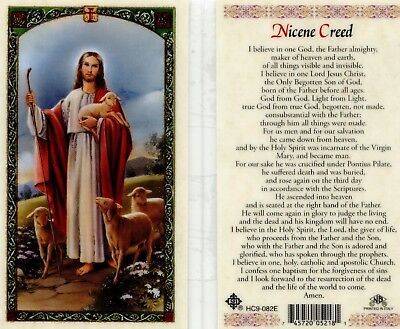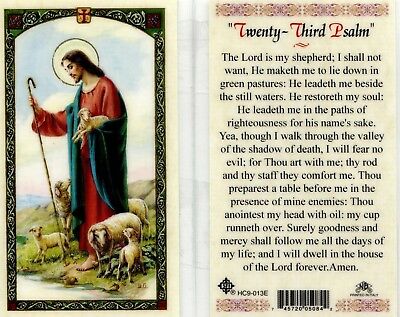-40%
Holy Card of Saint Óscar Romero Plus a 1" Silver Oxidized Medal of Saint Romero
$ 2.61
- Description
- Size Guide
Description
LaminatedHoly Card of Saint Óscar Romero Plus a 1" Silver Oxidized Medal, Made In Italy, of Saint
Óscar Arnulfo Romero y Galdámez.
Óscar Arnulfo Romero y Galdámez (15 August 1917 – 24 March 1980) was a prelate of the Catholic Church in El Salvador. He served as auxiliary bishop of the archdiocese of San Salvador, as bishop of Santiago de María, and finally as the fourth archbishop of San Salvador. As archbishop, Romero spoke out against social injustice and violence amid the escalating conflict between the military government and left-wing insurgents that led to the Salvadoran Civil War.[3] In 1980, Romero was shot by an assassin while celebrating Mass. Though no one was ever convicted for the crime, investigations by the UN-created Truth Commission for El Salvador concluded that Major Roberto D'Aubuisson, founder of the right-wing ARENA political party, had ordered the killing.
In 1997, Pope John Paul II bestowed upon Romero the title of Servant of God, and a cause for his beatification was opened by the church. The cause stalled, but was reopened by Pope Benedict XVI in 2012. Romero was declared a martyr by Pope Francis on 3 February 2015, paving the way for his beatification on 23 May 2015. During Romero's beatification, Pope Francis declared that his "ministry was distinguished by his particular attention to the most poor and marginalized." Pope Francis canonized Romero as a saint on 14 October 2018.
Seen as a social conservative at the time of his appointment as archbishop in 1977, Romero was deeply affected by the murder of his friend and fellow priest Rutilio Grande and thereafter became an outspoken critic of the military government of El Salvador. Hailed by supporters of liberation theology, Romero, according to his biographer, "was not interested in liberation theology" but faithfully adhered to Catholic teachings on liberation and a preferential option for the poor, desiring a social revolution based on interior reform. Up to the end of his life, his spiritual life drew much from the spirituality of Opus Dei.
In 2010, the United Nations General Assembly proclaimed 24 March as the "International Day for the Right to the Truth Concerning Gross Human Rights Violations and for the Dignity of Victims" in recognition of the role of Romero in defence of human rights. Romero actively denounced violations of the human rights of the most vulnerable people and defended the principles of protecting lives, promoting human dignity and opposing all forms of violence. Archbishop Jose Luis Escobar Alas, one of Romero's successors as Metropolitan Archbishop of the Roman Catholic Archdiocese of San Salvador, El Salvador, asked Pope Francis to proclaim Romero a Doctor of the Church, which is an acknowledgement from the church that his religious teachings were orthodox and had a significant impact on its philosophy and theology.
Latin American church groups often proclaim Romero an unofficial patron saint of the Americas and El Salvador; Catholics in El Salvador often refer to him as "San Romero", as well as "Monseñor Romero". Outside of Catholicism, Romero is honored by other Christian denominations including Church of England and Anglican Communion through the Calendar in Common Worship, as well as in at least one Lutheran liturgical calendar. Romero is also one of the ten 20th-century martyrs depicted in statues above the Great West Door of Westminster Abbey in London.
Romero was born on 15 August 1917 to Santos Romero and Guadalupe de Jesús Galdámez in Ciudad Barrios in the San Miguel department of El Salvador. On 11 May 1919, at the age of one, Óscar was baptized into the Catholic Church by the priest Cecilio Morales. He had five brothers and two sisters: Gustavo, Zaída, Rómulo, Mamerto, Arnoldo, and Gaspar, and Aminta (who died shortly after birth).
Romero entered the local public school, which offered only grades one through three. When finished with public school, Romero was privately tutored by a teacher, Anita Iglesias, until the age of thirteen. During this time Romero's father, Santos, trained him in carpentry. Romero showed exceptional proficiency as an apprentice. Santos wanted to offer his son the skill of a trade, because in El Salvador studies seldom led to employment. However, the boy broached the idea of studying for the priesthood, which did not surprise those who knew him.
Romero entered the minor seminary in San Miguel at the age of thirteen. He left the seminary for three months to return home when his mother became ill after the birth of her eighth child; during this time he worked with two of his brothers in a gold mine near Ciudad Barrios. After graduation he enrolled in the national seminary in San Salvador. He completed his studies at the Gregorian University in Rome, where he received a Licentiate in Theology cum laude in 1941, but had to wait a year to be ordained because he was younger than the required age. He was ordained in Rome on 4 April 1942. His family could not attend his ordination because of travel restrictions due to World War II. Romero remained in Italy to obtain a doctoral degree in Theology, specializing in ascetical theology and Christian perfection according to Luis de la Puente. Before finishing, in 1943 at the age of 26, he was summoned back home from Italy by his bishop. He traveled home with a good friend, Father Valladares, who was also doing doctoral work in Rome. On the route home, they made stops in Spain and Cuba, where they were detained by the Cuban police, perhaps for having come from Fascist Italy, and were placed in a series of internment camps. After several months in prison, Valladares became sick and Redemptorist priests helped to have the two transferred to a hospital. From the hospital they were released from Cuban custody and sailed on to Mexico, then traveled overland to El Salvador.
Romero was first assigned to serve as a parish priest in Anamorós, but then moved to San Miguel where he worked for over 20 years. He promoted various apostolic groups, started an Alcoholics Anonymous group, helped in the construction of San Miguel's cathedral, and supported devotion to Our Lady of Peace. He was later appointed rector of the inter-diocesan seminary in San Salvador. Emotionally and physically exhausted by his work in San Miguel, Romero took a retreat in January 1966 where he visited a priest for confession and a psychiatrist. He was diagnosed by the psychiatrist as having obsessive-compulsive personality disorder and by priests with scrupulosity.
In 1966, he was chosen to be Secretary of the Bishops Conference for El Salvador. He also became the director of the archdiocesan newspaper Orientación, which became fairly conservative while he was editor, defending the traditional Magisterium of the Catholic Church.
In 1970, Romero was appointed an auxiliary bishop for the Archdiocese of San Salvador. In 1974, he was appointed Bishop of the Diocese of Santiago de María, a poor, rural region.
On 23 February 1977, Romero was appointed Archbishop of San Salvador. While this appointment was welcomed by the government, many priests were disappointed, especially those openly supportive of Marxist ideology. The progressive priests feared that his conservative reputation would negatively affect liberation theology's commitment to the poor.
On 12 March 1977, Rutilio Grande, a Jesuit priest and personal friend of Romero who had been creating self-reliance groups among the poor, was assassinated. His death had a profound impact on Romero, who later stated: "When I looked at Rutilio lying there dead I thought, 'If they have killed him for doing what he did, then I too have to walk the same path.'" Romero urged the government to investigate, but they ignored his request. Furthermore, the censored press remained silent.
Tension was noted by the closure of schools and the lack of Catholic priests invited to participate in government. In response to Grande's murder, Romero revealed an activism that had not been evident earlier, speaking out against poverty, social injustice, assassinations and torture.
In 1979, the Revolutionary Government Junta came to power amidst a wave of human rights abuses by paramilitary right-wing groups and the government, in an escalation of violence that would become the Salvadoran Civil War. Romero criticized the United States for giving military aid to the new government and wrote an open letter to President Jimmy Carter in February 1980, warning that increased US military aid would "undoubtedly sharpen the injustice and the political repression inflicted on the organized people, whose struggle has often been for their most basic human rights." This letter was then sent, via telegram, from the U.S. embassy in El Salvador to Washington D.C. Carter did not directly respond to the letter; instead, Cyrus Vance, the Secretary of State, wrote a telegram back to the U.S. embassy. The telegram carried a very contradictory message, both stating that the United States will not interfere but will respond to the Revolutionary Government Junta's requests. It is unknown if Archbishop Romero received the telegram.
On 11 May 1979, Romero met with Pope John Paul II and unsuccessfully attempted to obtain a Vatican condemnation of the right-wing El Salvador's regime for violations of human rights during the Salvadoran Civil War and its support of death squads, and expressed his frustration in working with clergy who cooperated with the government. He was encouraged by John Paul II to maintain episcopal unity as a top priority.
As a result of his humanitarian efforts, Romero began to be noticed internationally. In February 1980, he was given an honorary doctorate by the Catholic University of Louvain.
Romero denounced the persecution of members of the Catholic Church who had worked on behalf of the poor:
In less than three years, more than fifty priests have been attacked, threatened, calumniated. Six are already martyrs--they were murdered. Some have been tortured and others expelled [from the country]. Nuns have also been persecuted. The archdiocesan radio station and educational institutions that are Catholic or of a Christian inspiration have been attacked, threatened, intimidated, even bombed. Several parish communities have been raided. If all this has happened to persons who are the most evident representatives of the Church, you can guess what has happened to ordinary Christians, to the campesinos, catechists, lay ministers, and to the ecclesial base communities. There have been threats, arrests, tortures, murders, numbering in the hundreds and thousands.... But it is important to note why [the Church] has been persecuted. Not any and every priest has been persecuted, not any and every institution has been attacked. That part of the church has been attacked and persecuted that put itself on the side of the people and went to the people's defense. Here again we find the same key to understanding the persecution of the church: the poor.
On 24 March 1980, Romero delivered a sermon in which he called on Salvadoran soldiers, as Christians, to obey God's higher order and to stop carrying out the government's repression and violations of basic human rights.
Romero spent 24 March in a recollection organized by Opus Dei, a monthly gathering of priest friends led by Fernando Sáenz Lacalle. On that day they reflected on the priesthood. That evening, Romero celebrated Mass at a small chapel at Hospital de la Divina Providencia (Divine Providence Hospital), a church-run hospital specializing in oncology and care for the terminally ill. Romero finished his sermon, stepped away from the lectern, and took a few steps to stand at the center of the altar.
As Romero finished speaking, a red automobile came to a stop on the street in front of the chapel. The gunman emerged from the vehicle, stepped to the door of the chapel, and fired one (possibly two) shots. Romero was struck in the heart, and the vehicle sped off.











